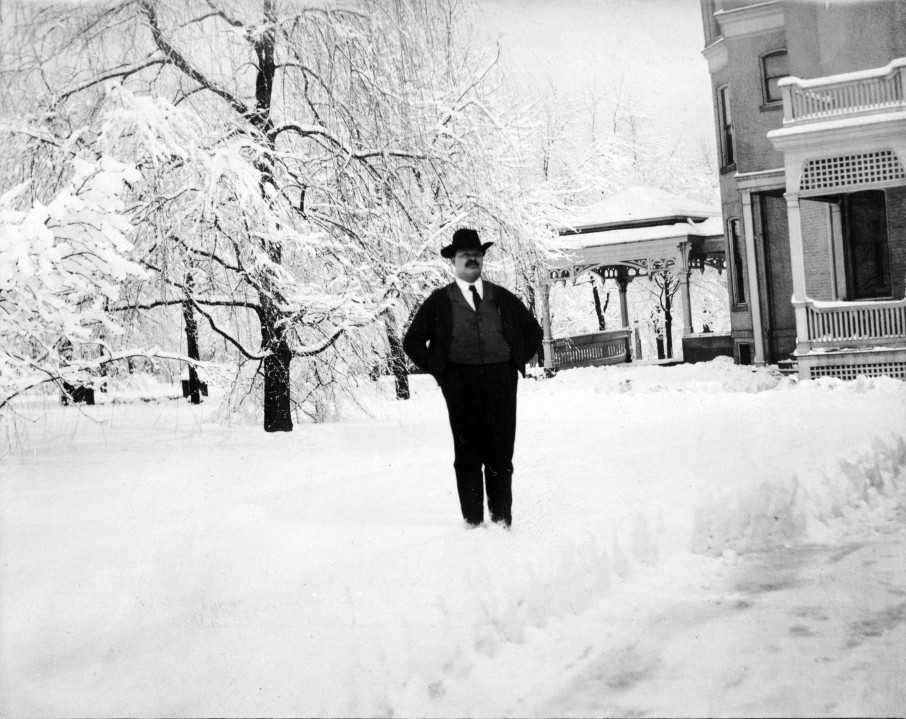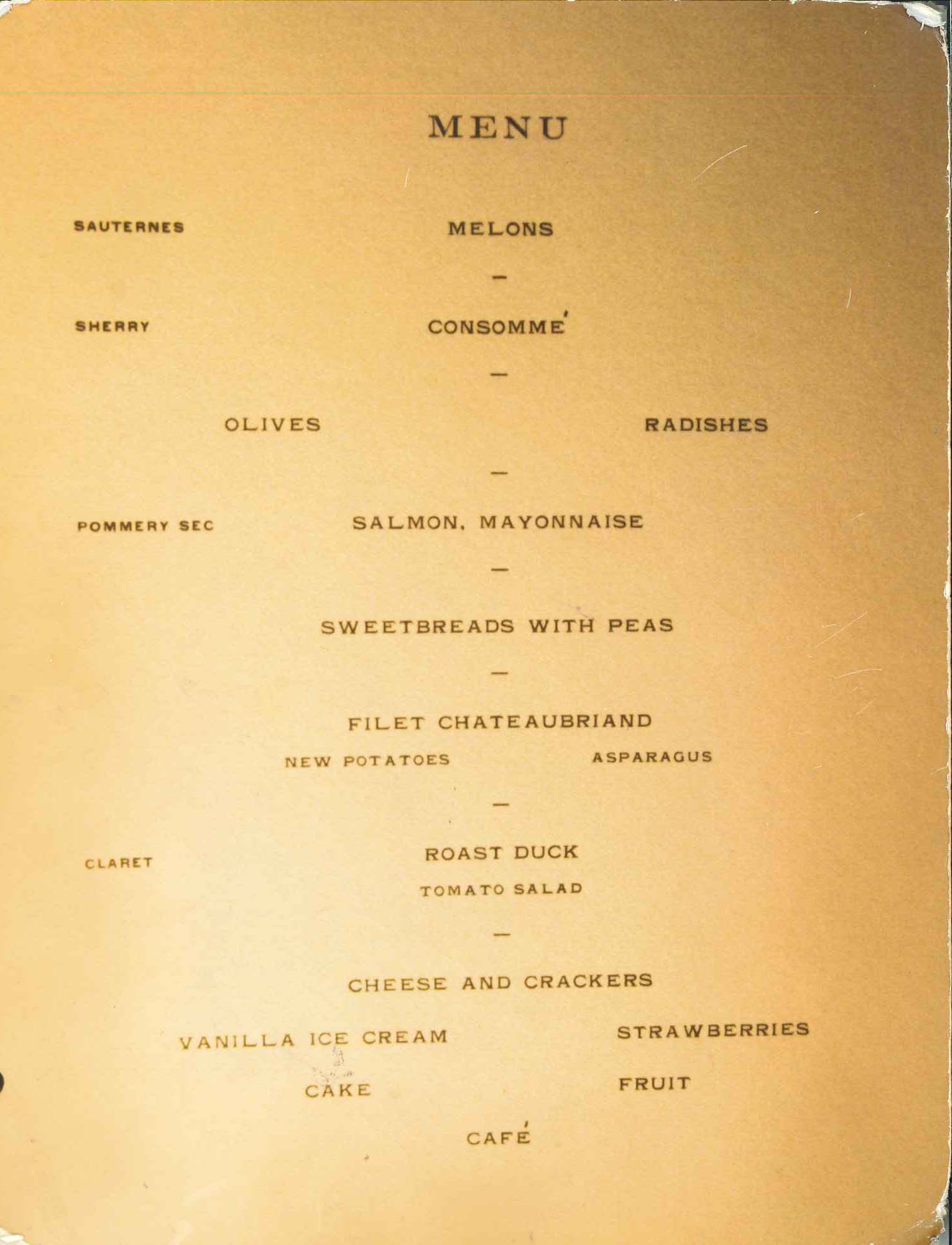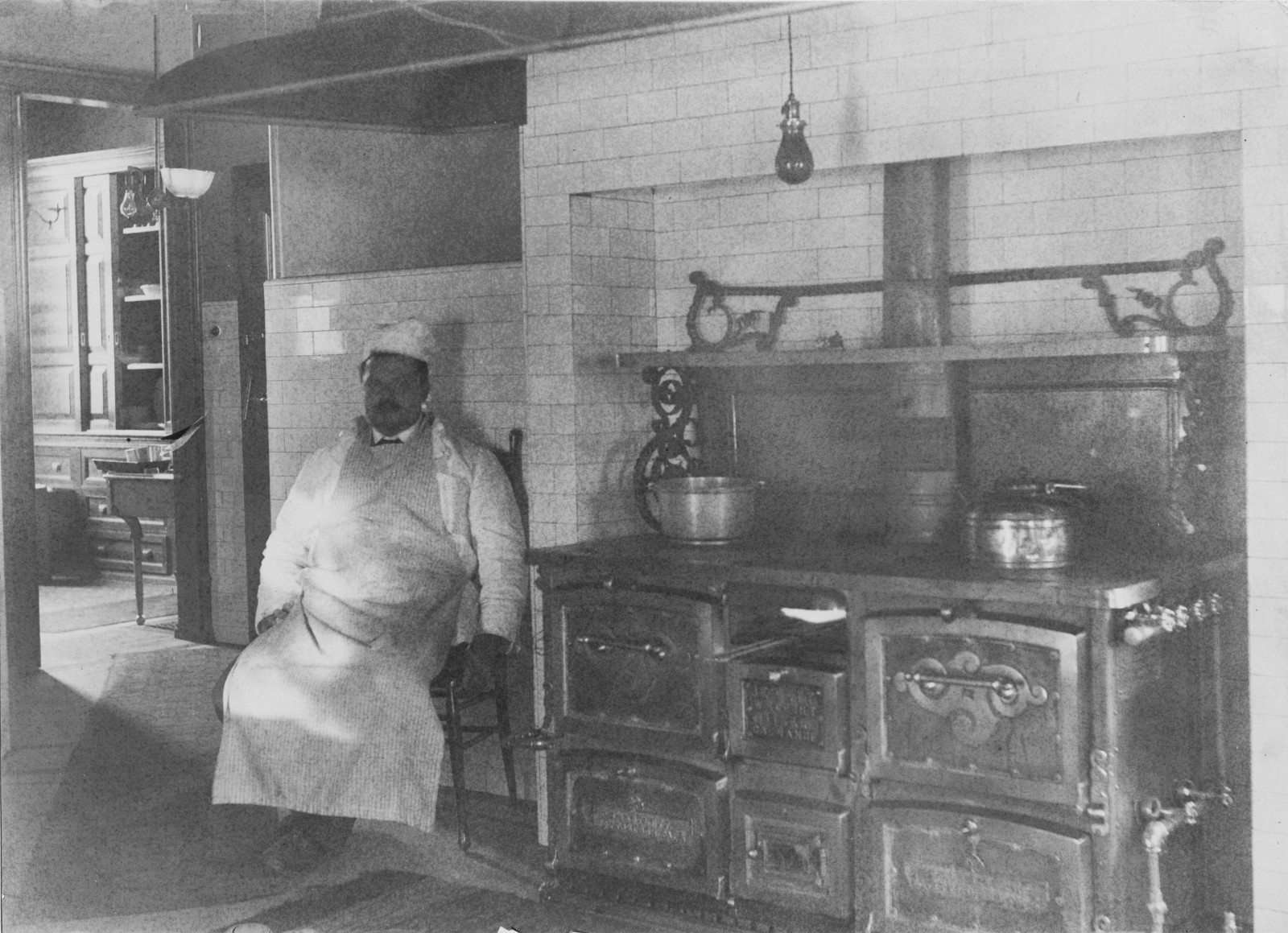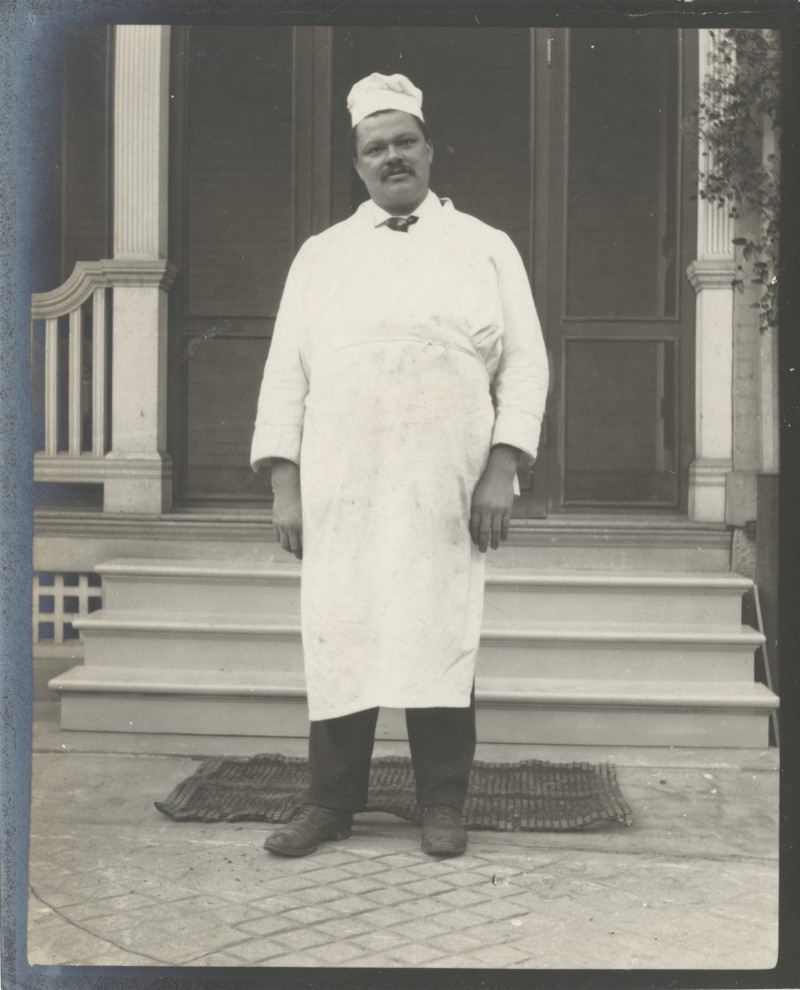You’ve probably heard the phrase, “The kitchen is the heart of the home.” For residents of Clayton, both the Fricks and the staff living there, Spencer Ford, their chef, was the person shaping that “heart.” Spencer Ford was the Frick family chef for at least 16 years.
Spencer was born in Virginia on October 15, 1864. Though the existing payroll records for Clayton only start in 1892, we know that Spencer was living in Pittsburgh as early as 1888, when he married his wife, Hattie. Hattie was also from Virginia, and at the time of their marriage, they were living in Pittsburgh’s 21st Ward. In 1899 he was shown as living on Aurelia Street in the Shadyside neighborhood of Pittsburgh. Spencer never lived in Clayton itself, but it was likely that he lived close to the home since he was there every day, probably early in the morning and late at night. The 21st Ward stretched from the Allegheny River to the Liberty neighborhood which butted up to the property that the Frick’s owned.

Spencer Ford stands outside Clayton during a snowstorm.
Photo courtesy of the Frick Art Reference Library.
Clayton was often a busy home that served multiple purposes. The Fricks were hosting family and friends along with business partners and politicians. As the household chef, Spencer was an integral part of a successful visit to the home. In 1902, President Theodore Roosevelt visited Clayton for a luncheon. While this luncheon was catered by Hotel Schenley, others like it took place on a regular basis. Events of this size would have been hosted around the holidays or for important business meetings. To create these experiences, Spencer would have worked closely with Adelaide Frick to curate this menu and would have created it with the help of other household staff, like Mary Coyne and Nellie Lupton.

While Spencer was used to cooking for large groups and important occasions, daily life at Clayton also asked a lot of the chef. He was expected to prepare six meals per day: three meals for the Frick family and three for the staff living and working in the home. In addition to providing these courses for everyone living in the home, Spencer was also tasked with organizing grocery buying and preparation. During his time working for the family, he developed a relationship with them, especially with Childs Frick, who he exchanged correspondence with when he was away at boarding school in Cambridge, Massachusetts.
For upper class families, dining was an important and well-orchestrated event: “The hour of dinner has been pronounced … to be, in civilized life, the most important hour of the twenty-four.” For fancier meals and events, it was typical to have up to eight distinct courses. Creating and preparing for these occasions was an extensive task for Spencer. Cooking a consommé could take up to five hours depending on the recipe, plus Spencer would have had to pickle any of the food like radishes that would have been eaten between courses. In addition, menus often included several complicated meat dishes that each include sides. Luncheons like this one also included multiple desserts. For example, anytime ice cream was on the menu it was likely made fresh in the kitchen. Hand-churning ice cream for large groups of people would have been extremely time consuming and physically rigorous. Prep for some of these events would have started days, if not weeks, beforehand, all while preparing the daily meals for staff and family.

Even though Spencer worked for the Fricks for many years, his salary changed very little over that spread of time. In 1892 his wages were $35 (approximately $1,200 today) per month, rising in 1894 to $40 (approximately $1,300 today) per month. This $40 remained consistent for the remainder of the time that he worked for the family until 1909. Comparatively, Ford made more than any of the women who worked in the house but only about half of what the men on the grounds crew, like David Fraser, or the coachman, James Elmore, were making, both of whom were white men. In comparison, when the Fricks moved to New York City in 1905, they paid their new French chef $150 a month. During Spencer’s tenure with the family, payroll records and personal correspondence between Henry Frick’s assistant, F.W. McElroy, and Spencer indicate that he consistently requested advances on his paychecks, usually for at least half of his pay. These requests became more common in the early 20th century when Spencer had been making the same salary for over a decade.

Spencer Ford stands outside the back door of Clayton.
Photo courtesy of the Frick Art Reference Library.
Spencer did not move with the family to New York in 1905, instead remaining to work in Clayton until late 1909. The Fricks returned to visit Clayton often and the house remained staffed even when the family was not in Pittsburgh, so Spencer would have continued his daily tasks of meal preparation during those years. The 1920 census shows Spencer and his wife Hattie living in Washington, DC, where he continued his work as a chef at a hotel. He passed away shortly after in 1921.
Bibliography
Frick Payroll 1892-1912
“Deaths Reported.” The Washington Post, November 20, 1921.
Ford, Spencer. Letter to Childs Frick, November 20, 1893.
Leslie, Eliza. The Ladies’ Guide to Perfect Manners: Miss Leslie’s Behavior Book, 1853.
Marriage License - Spencer Ford. 1864.
“Twenty-First Ward, Pittsburgh.” 1872. Map. Historic Pittsburgh.
Spencer was born in Virginia on October 15, 1864. Though the existing payroll records for Clayton only start in 1892, we know that Spencer was living in Pittsburgh as early as 1888, when he married his wife, Hattie. Hattie was also from Virginia, and at the time of their marriage, they were living in Pittsburgh’s 21st Ward. In 1899 he was shown as living on Aurelia Street in the Shadyside neighborhood of Pittsburgh. Spencer never lived in Clayton itself, but it was likely that he lived close to the home since he was there every day, probably early in the morning and late at night. The 21st Ward stretched from the Allegheny River to the Liberty neighborhood which butted up to the property that the Frick’s owned.
Spencer Ford stands outside Clayton during a snowstorm.
Photo courtesy of the Frick Art Reference Library.
Clayton was often a busy home that served multiple purposes. The Fricks were hosting family and friends along with business partners and politicians. As the household chef, Spencer was an integral part of a successful visit to the home. In 1902, President Theodore Roosevelt visited Clayton for a luncheon. While this luncheon was catered by Hotel Schenley, others like it took place on a regular basis. Events of this size would have been hosted around the holidays or for important business meetings. To create these experiences, Spencer would have worked closely with Adelaide Frick to curate this menu and would have created it with the help of other household staff, like Mary Coyne and Nellie Lupton.
The menu of the luncheon catered by Hotel Schenley for President Theodore Roosevelt's visit. Spencer would have cooked meals similar to this regularly.
Photo courtesy of the Frick Art Reference Library.
Photo courtesy of the Frick Art Reference Library.
While Spencer was used to cooking for large groups and important occasions, daily life at Clayton also asked a lot of the chef. He was expected to prepare six meals per day: three meals for the Frick family and three for the staff living and working in the home. In addition to providing these courses for everyone living in the home, Spencer was also tasked with organizing grocery buying and preparation. During his time working for the family, he developed a relationship with them, especially with Childs Frick, who he exchanged correspondence with when he was away at boarding school in Cambridge, Massachusetts.
For upper class families, dining was an important and well-orchestrated event: “The hour of dinner has been pronounced … to be, in civilized life, the most important hour of the twenty-four.” For fancier meals and events, it was typical to have up to eight distinct courses. Creating and preparing for these occasions was an extensive task for Spencer. Cooking a consommé could take up to five hours depending on the recipe, plus Spencer would have had to pickle any of the food like radishes that would have been eaten between courses. In addition, menus often included several complicated meat dishes that each include sides. Luncheons like this one also included multiple desserts. For example, anytime ice cream was on the menu it was likely made fresh in the kitchen. Hand-churning ice cream for large groups of people would have been extremely time consuming and physically rigorous. Prep for some of these events would have started days, if not weeks, beforehand, all while preparing the daily meals for staff and family.
Spencer Ford sitting in the kitchen of Clayton, next to the stove.
Photo courtesy of the Frick Art Reference Library.
Photo courtesy of the Frick Art Reference Library.
Even though Spencer worked for the Fricks for many years, his salary changed very little over that spread of time. In 1892 his wages were $35 (approximately $1,200 today) per month, rising in 1894 to $40 (approximately $1,300 today) per month. This $40 remained consistent for the remainder of the time that he worked for the family until 1909. Comparatively, Ford made more than any of the women who worked in the house but only about half of what the men on the grounds crew, like David Fraser, or the coachman, James Elmore, were making, both of whom were white men. In comparison, when the Fricks moved to New York City in 1905, they paid their new French chef $150 a month. During Spencer’s tenure with the family, payroll records and personal correspondence between Henry Frick’s assistant, F.W. McElroy, and Spencer indicate that he consistently requested advances on his paychecks, usually for at least half of his pay. These requests became more common in the early 20th century when Spencer had been making the same salary for over a decade.
Spencer Ford stands outside the back door of Clayton.
Photo courtesy of the Frick Art Reference Library.
Spencer did not move with the family to New York in 1905, instead remaining to work in Clayton until late 1909. The Fricks returned to visit Clayton often and the house remained staffed even when the family was not in Pittsburgh, so Spencer would have continued his daily tasks of meal preparation during those years. The 1920 census shows Spencer and his wife Hattie living in Washington, DC, where he continued his work as a chef at a hotel. He passed away shortly after in 1921.
Bibliography
Frick Payroll 1892-1912
“Deaths Reported.” The Washington Post, November 20, 1921.
Ford, Spencer. Letter to Childs Frick, November 20, 1893.
Leslie, Eliza. The Ladies’ Guide to Perfect Manners: Miss Leslie’s Behavior Book, 1853.
Marriage License - Spencer Ford. 1864.
“Twenty-First Ward, Pittsburgh.” 1872. Map. Historic Pittsburgh.




